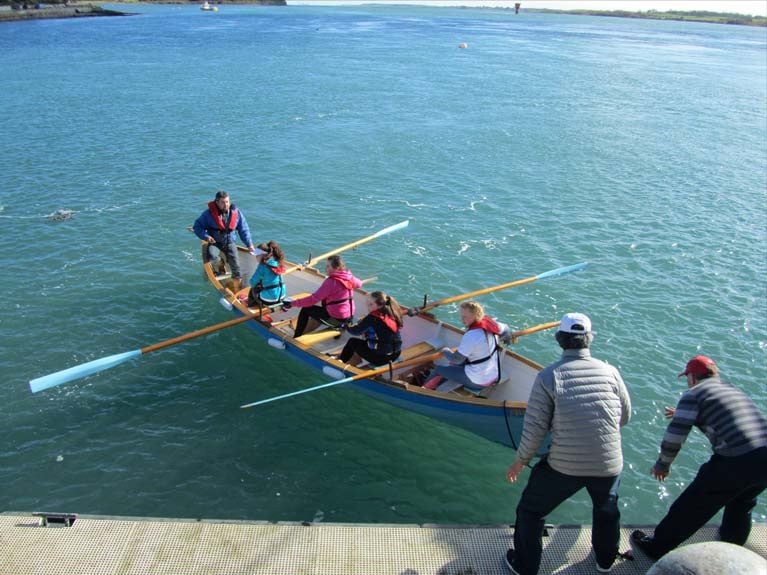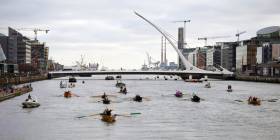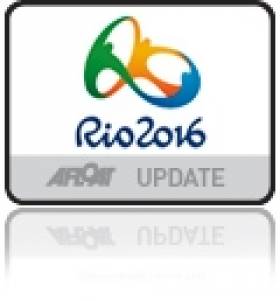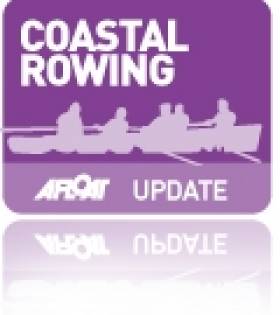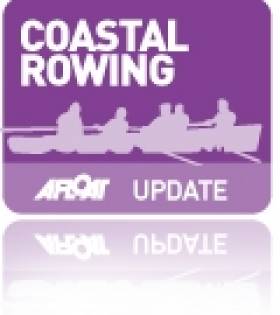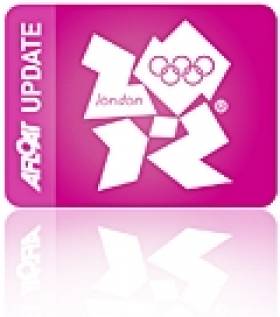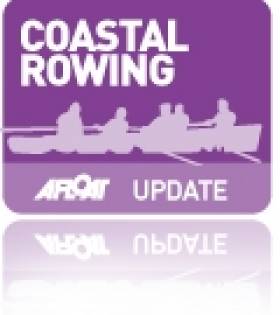Displaying items by tag: Skiff
Carrigaholt On The Shannon Estuary Loops Into The Skiff Movement
Carrigaholt on the south-facing shore of the Outer Shannon Estuary is one of the sweetest places in all Clare, a refreshingly leisurely contrast to the over-busy northwest of the county, where the once tiny port of Doolin finds itself swamped with tourists expecting to do a one-day box-ticking exercise on the Cliffs of Moher, the shortest boat-hop out to the Aran islands, and the marvellous mystery of The Burren.
CARRIGAHOLT GIVES PEACE OF MIND
But Carrigaholt is what passes for the capital of the remote-feeling Loop Head peninsula, which is as much an attitude as a place. It has a strong sense of community that manifests itself in many ways, not least in the people of Querrin along the south shore getting together a decade and more ago to build the Sally O’Keeffe, the gaff-cutter-rigged Myles Stapleton-designed interpretation of the classic Shannon Estuary Hooker. These were traditional boats that used to carry passengers and cargo from Limerick the length and breadth of this magnificent 60-mile waterway.
 Seol Sionna’s multi-purpose gaff cutter Sally O’Keeffe was built at Querrin in a community project under the guidance of Steve Morris
Seol Sionna’s multi-purpose gaff cutter Sally O’Keeffe was built at Querrin in a community project under the guidance of Steve Morris
The Querrin boatbuilders created the Sally O’Keeffe under the guidance of master boat-builder Steve Morris, the New Zealander who was enticed to Ireland by his wife, a Kilrush girl, and has been an asset to that developing port and its larger community ever since. His work in the boatyard is of such a high quality that he was the natural choice to re-build the Dublin Bay 21s for Hal Sisk and Fionan de Barra, and there are always other fascinating projects under way in the busy sheds.
 The boat-building man…..the enthusiasm of Steve Morris seems to be boundless
The boat-building man…..the enthusiasm of Steve Morris seems to be boundless
Yet despite high quality boat-building being the day job, his enthusiasm is such that he gave over his evenings to guide Seol Sionna in their building of the Sally O’Keeffe, and more recently he did the same to help them build an Ian Oughtred-designed St Ayles skiff, that handy team-rowing boat which is of a more manageable size for shore transport than the hefty traditional Irish coastal rowing skiff.
ST AYLES SKIFFS GET ABOUT
One of the attractions of the St Ayles skiff is the opportunity for international competition, as they have now spread worldwide. But more importantly for Steve Morris and his friends, whose boat Ealu went to last year’s Morbihan Festival in South Brittany as well as doing the Sea to the City fleet row in Cork Harbour, they are now spreading westward into the Loop Head peninsula.
 Seol Sionna’s Kilrush-built St Ayles skiff Ealu has proudly carried the colours of Ukraine to the Morbihan Festival in south Brittany and the Sea to City parade in Cork Harbur.
Seol Sionna’s Kilrush-built St Ayles skiff Ealu has proudly carried the colours of Ukraine to the Morbihan Festival in south Brittany and the Sea to City parade in Cork Harbur.
Last Saturday – Storm Isha’s approach notwithstanding – building work was started on another St Ayles skiff - with support from Limerick & Clare Education Board - by Loop Head Rowing Club in a handy shed at Kilrush’s Outer Pier, right beside the ancient stronghold of the Mac Mahons.
CARRIGAHOLT AND THE ILEN
Its eloquent presence ensured that in the days when Gary Mac Mahon was running the Conor O’Brien trading ketch Ilen in the years immediately after her restoration under his inspiration, there were several memorable occasions when Ilen was anchored in stately style below the castle. And though all sorts of chicanery resulted in the Mac Mahons not being the occupants of the 15th Century castle in its final residential days, it’s right and proper that the newly-formed skiff-build team of 16 Loopers not only includes six female boat enthusiasts, but as well Marcus McMahon and two of his children are involved.
 Last Saturday’s first gathering at Carrigaholt of the Loop Head Rowing Club’s build team include (left to right) Con Minihan, James Devane, Michael Griffin, Fintan Ryan, Jill Leonard, Emma Clark, Paul Daly and Marcus McMahon with his two children, Photo: Steve Morris
Last Saturday’s first gathering at Carrigaholt of the Loop Head Rowing Club’s build team include (left to right) Con Minihan, James Devane, Michael Griffin, Fintan Ryan, Jill Leonard, Emma Clark, Paul Daly and Marcus McMahon with his two children, Photo: Steve Morris
Saturday visitors are welcome at the Loop Head Rowing project, and with several notably hospitable establishments in the main part of the village beside the inner harbour known to Shannon sailors as the Long Dock, with the Long Dock pub itself being renowned for it excellent food, there are now even more reasons for visiting Carrigaholt by sea or land.
 The main part of Carrigagholt, where the notably hospitable Long Dock food pub takes its title from the Shannon sailors’ name for the inner harbour
The main part of Carrigagholt, where the notably hospitable Long Dock food pub takes its title from the Shannon sailors’ name for the inner harbour
Over the May bank holiday weekend, Tralee Bay welcomed a few speed addicts for the first Skiff West event (also incorporating the second edition of the 29er westerns).
Saturday set the scene with the TBSC opening regatta. The local dinghy sailors saw the addition of the visiting 29er youth team. Three races were completed in a brisk 14-16 knots westerly. The 29ers trusted the front positions in these planning conditions with National YC sailors Ben O'Shaughnessy and Ethan Spain taking all three races on PY. Johnny Flynn and James Dwyer were equally consistent in second. There was certainly more of a battle for the last podium position with locals making the most of the mistakes of the remaining 29ers. Ellie Cunnane (radial) eventually edged out her brother Paddy (Std rig), Riain Kelly (4.7 rigs) and father and son Mirror partnership.
On Sunday the skiffs took to the water again in a lovely 10-12 knots from the northwest. The local dolphins joined again to set the scene for great sailing.
 Skiff West champions - Ben O'Shaughnessy and Ethan Spain
Skiff West champions - Ben O'Shaughnessy and Ethan Spain
In the first race, the two single handers Thomas Chaix (RS700) and Chris Bateman (Musto Skiff) made the best of the 29er errors to take an early lead with a very close finish within a pole length of each other. It was however short of a few boat lengths for both of them when times were recalculated with 29er Johnny Flynn and James Dwyer squeezing the win for just a few seconds.
The breeze picked up a bit putting pressure on the single-handers boat handling allowing the 29ers to enjoy more comfortable wins with Ben O'Shaugnessy and Ethan Spain leading the pack with Johnny and James close second each time. Four well-fought races were completed to put the tally at 5 for the day.
Monday welcomed the sailors with a glass mirror in the bay... The forecast was not encouraging so the race officer called it a championship early. The 29ers elected to pack but Chris and Thomas rigged up the Musto, the RS and a 49er and the fleet was rewarded with an hour of great wind just after lunch.
Overall, NYC sailors Ben O'Shaughnessy and Ethan Spain secured the overall of "Skiff West 2022" and the 29er Westerns ahead of Johnny Flynn and James Dwyer also on a 29er and Chris Bateman (MBSC) on his Musto Skiff. Chris secured the first perpetual trophy of the open skiff fleet.
If numbers could certainly have been a bit higher, anyone who made the trip to Kerry enjoyed a fast and fun weekend and we will keep working at building a fleet mixing informal coaching skiff weekends with more serious skiff racing.
The next event is 25-26 June in Blessington.
Tralee Bay Stages Skiff Event Over May Bank Holiday Weekend
Tralee Bay Sailing Club in County Kerry is gearing up for a weekend of sailing on the west coast over the May Bank Holiday weekend.
The weekend will start with the club's yearly "Spring Regatta". Four races are scheduled on Saturday, the 3rd of April for the Optimist and dinghy fleets of the club.
The regatta is however open to visitors and last year saw the addition of 29er sailors from Dublin, GP14s from Cullaun and sailors from neighbouring club Foynes.
The weekend will then carry on with the combined 29er westerns and the first-ever "Open Skiff West" event.
The return of a regular season at home has been long awaited for the 29er fleet and the Westerns will launch a great summer of sailing and racing for the fleet. It will be the opportunity for the seasoned partnerships who have raced abroad over the winter to chase home waters honours and for the new partnerships to get finally introduced to racing. Who will add their name under 2019 champions Atlee Kohl and Jonathan O'Shaugnessy?
Skiff sailing is fun and there are many sailors around the country who have enjoyed the thrills of fast downwinds in their local club races. TBSC is offering the opportunity to gather all these speed addicts in a single venue for two days giving the opportunity to share tricks and stories with the more experienced sailors helping out the less experienced to get the most out of their boat. 49er and 49erFX should provide the bulk of the fleet yet we are also expecting a few of the trapezing RS (600, 700 and 800), Musto skiffs and some of the older skiff designs which still line up in various club boat parks around the country.
The event will be run under PY.
Details and entry form are on the Tralee Bay Sailing Club website, download the two NORs below.
Coastal Rowing in Northern Ireland Revival Continues
County Down has become an important centre for coastal rowing with clubs dotted around Strangford Lough and the Ards Peninsula. This is very much a community-based activity with skiffs active at Strangford, Portaferry, Portavogie, Donaghadee, Dundrum, Killyleagh, Sketrick, Strangford, and Kircubbin. There is also rowing at Ardglass and Ballywalter.
Down Coastal Rowing Association was set up in 2014 by the Strangford Lough and Lecale Partnership (SLLP) working with the PSNI to revive traditional boatbuilding and coastal rowing as part of a wider effort to regenerate communities through their maritime heritage. It was approved by the Down Rural Area Partnership (DRAP) as part of the European Agricultural Fund for Rural Development: Europe investing in rural areas, supported by the Northern Ireland Environment Agency, and Down District and Ards Borough Councils.
This revival of an old sport has been a phenomenal success with community boats built, virtually all St Ayles skiffs, and clubs established. The St Ayles class has spread very quickly with numbers growing all the time. A key player in the construction of the boats is Jeremy Duffin of Strangford.
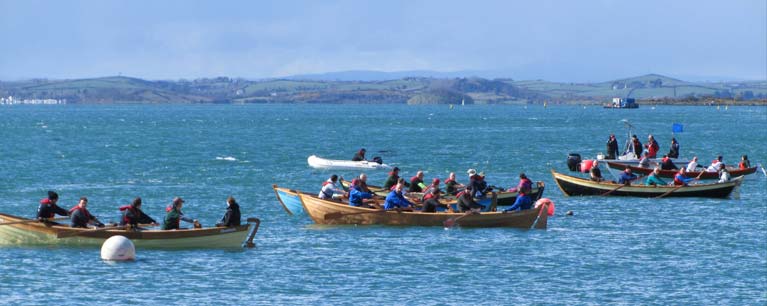 Northern Ireland coastal rowing
Northern Ireland coastal rowing
Strangers become friends and teamworking has forged relationships across and between communities. There is also healthy competition and each community holds training and competitive activities all year round.
"Teamwork has forged relationships across and between communities"
The rowing has also brought people into contact with the area's landscape and wildlife and they, in turn, have helped to look after it, taking care not to disturb seals and birds and taking part in shore clean-ups. This is important because Strangford Lough is an Area of Special Scientific Importance.
The World Championships, (Skiffie Worlds) were held in Strangford Lough in 2016, hosted by Strangford Lough & Lecale Partnership (SLLP) working closely with the Scottish Coastal Rowing Association (SCRA), and with the support of local councils and communities along the County Down Coast. Last year Stranraer hosted the World Championships in which the Dundrum team were the overall winners.
Skiff Racing a Knockout for Former World Champion
Niall O’Toole, the first Ireland world champion in Olympic-class rowing who now runs indoor rowing courses, remembers fondly how he was invited to race in a boat class that goes back over a century.
Cracking the Code of East Coast Skiff Racing
By Niall O’Toole
It was a dreary November night. A green army of St. Patrick’s singlets filed into the room. I wanted to make a good first impression before our first indoor rowing session began. I proceeded to introduce myself. “Hi Guys, I’m Niall O’Toole, three-time Olympian, world champion, former world record holder and multi world medallist”. A deadly silence swept through the room. I didn’t hear any expletives, but their faces said it all.
Three months passed before there was any glimmer of recovery. Then, came the request: “Would you like to race skiffs, Niallo?”. I expected to go through a data-driven, seat-racing selection process, but discovered that crew selection was considered more an art form than a science. In quiet corners, canny, skiff insiders decide the fates of crews, as they have done since the late 19th Century, where the tradition of ‘Hobbling’ first began. Back then skiffs raced for piloting rights to cargo ships. Now the tradition of racing skiffs continues. So it was that I joined my first skiff crew and started training.
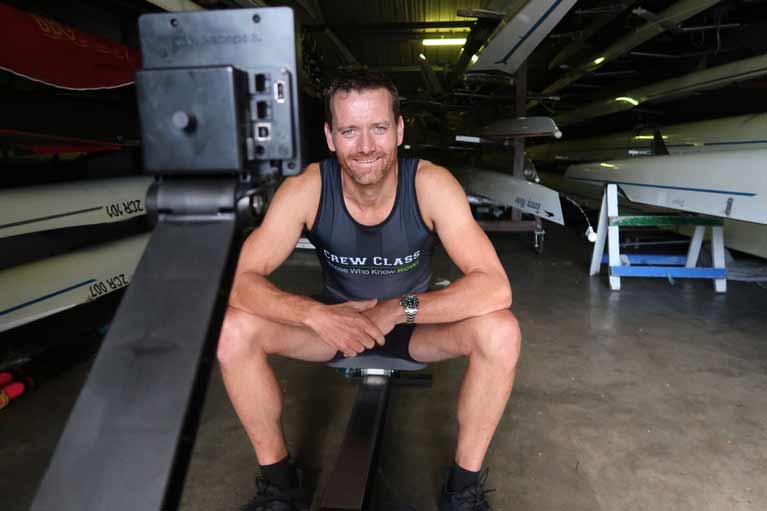 Niall O’Toole
Niall O’Toole
The first thing I noticed was the beauty of the boats. I was used to brittle carbon fibre Olympic missiles, built to specific weights and criteria, which seem dull and lifeless by comparison. Skiffs are living, breathing works of craft, ever-changing over time and lovingly maintained by obsessive boatmen; men like my late father Jimmy O’Toole. He was a shipwright for Guinness on the Lady Patricia, which brought crates of the black stuff to Liverpool. He built and repaired many wooden boats in his time, including one in the back garden of our terraced house, which turned out to be too big to get out. Fifteen hedges, fences and brick walls later, he slotted it out through a break between two houses.
Being surrounded by wooden boats again brought back fond memories of my Dad. I’m still none the wiser about what clubs deem a ‘fast’ or ‘slow’ boat’, though.
Crews grow comfortably accustomed to their skiff’s quirks, and are suspicious of change. A new boat into the club can find itself labelled ‘slow’ and relegated to life on a rack. The mythology around oars is unique too – no two wooden oars are exactly the same. Weight, stiffness, size of blade, handle-width and grip all play into making the perfect oar for any one individual’s taste. It took me weeks to find an oar that gripped the water the way I liked. I marked it with tape to make it easy to find again, but found that tape is easily removed and an oar easily hidden. I’ve seen many a ruckus on the dock over an oar that found itself favoured by two crews.
My first race for St Pat’s was in Dun Laoghaire. A stalwart of the club, Philip Murphy, whispered in my ear: “It’s rough out there Tooler! Make sure you get water.” I wasn’t sure what he meant. Due to the rise and fall of the boat, it was impossible to adjust your hand position enough to stay in contact with the water. Pulling air doesn’t give you boat speed, but we managed to lead the race into the first turn.
Prematurely, I saw myself adding another notch to my glittering rowing career, when amidst the whirlwind of cox’s screams, burning lungs, and the strength-sapping manoeuver of trying to use my oar as a handbrake to swing the boat around, we exited the turn in second-last place. We tried to pick up the pace, but the water was just too big to make up any of the ground we’d lost. Then we rounded the second buoy to find a rogue skiff on a bad line coming straight for us. I ducked and heard an almighty crack. ‘Skipper’, my crewmate, was clocked with an oar to the head and knocked clean out, hitting the bottom of the boat with a thud. Stuff like that just never happens at the Olympics!
I spent the next couple of months learning the subtleties of the sport; learning the craft, culture and code. It’s not all about straight-line speed - you do need to be fit and fast, but it’s also about currents, streams, winds, waves, tides and a little help from lady luck. It’s about your cox finding the fastest racing line and your crew communicating around the turn with their lungs on fire. I came to realise that the physical exertion and pain you feel in skiff racing is every bit as tough as the Olympic sport I know. Most importantly, I learnt that St. Pat’s is truly a community based club; in that humble old Dublin, no-nonsense kind of way. In a club where people truly look out for each another, I found a warm welcome, a sense of place and lifelong friends. In the twilight of my rowing career, I had no idea that was possible.
The All In A Row charity event will be held on the Liffey on Saturday, November 30th. Rowing, kayak and canoe clubs along with private rowing boat owners can be part of a 10-hour row/paddle to raise money for both the RNLI and The Irish Underwater Search and Recovery Unit. The boats will travel from St Patrick’s Rowing Club at Tom Clarke Bridge (formerly East Link Bridge) to Heuston Station Bridge and to the Grattan Bridge during high tide. During low tide it can be viewed along the banks of the Liffey.
49er Skiff Pair Pair Seaton & McGovern Lie 12th at World Championships
#irish49er – Ryan Seaton & Matt McGovern are 12th overall after Day 2 of the 49er World Championships. The Belfast lough pairing were placed 9th, 14th and 5th in the 97 boat fleet.
For full results and live tracking see http://49er.org/2013-world-championships/
Skerries Club Prepares to Launch 'Super Fast' Rowing Skiff
Skerries Rowing Club is marching its new coastal rowing skiff down South Strand, Skerries this Saturday afternoon before launching and naming the new clinker built boat at the Slip on Harbour Road, (opposite the sailing club) in Skerries, North Dublin.
The club is also taking the opportunity on Saturday to thank master boat builder Martin O'Toole and Ciaran 'Chopper' McCarthy, a cabinet maker, for their dedication and skill in building what the club claims will be a 'super fast' rowing craft.
Flatpack Coastal Rowing Skiff Is All The Rage
#CoastalRowing - News comes from Scotland of an intriguing new coastal rowing craze that sounds like something from a Swedish furniture store!
As the Guardian reports, a traditional Scottish fishing skiff design provided the inspiration for the new flatpack coastal rowing boat, which began life as a prototype project for the Scottish Fisheries Museum four years ago.
Since then the St Ayles skiff concept swept like a wave across the UK and beyond - and examples of the DIY kit row boat, which is handmade in Fife, can be found as far afield as Australia.
Many of those international rowers are expected to converge in Scotland this simmer for the coastal rowing world championships off Ullapool.
The Guardian has much more on the story HERE.
No Medal Race for Irish 49er Campaign
#49er – Ireland's 49er Belfast skiff campaign has ended without the much hoped for medal race participation.
Today's last day of fleet racing was Ryan Seaton and Matt McGovern's last opportunity to hold on to a top ten position before next Wednesday's medal race.
The pair were tenth overall heading in to Race 14 but only four points separated them from 13th place. Seaton and McGovern finished in 16th which saw them drop to 11th overall. Sadly Race 15 had an equally frustrating ending, seeing the pairing finish in 16th and 14th overall ultimately ending their dreams of racing in the medal race.
Traditional Skiff Rowing Comes to Dun Laoghaire
#skiffracing – St. Michael's rowing club in Dun Laoghaire will host its leg of the East Coast Rowing calendar on Sunday 24th June. The regatta will take place from the town's West Pier to the North of Seapoint Tower, with teams competing from all over the East Coast. The first race begins at 2pm with the finale at around 6pm.
This year's event, co sponsored by Dun Laoghaire County Council, will see hundreds of men women and children compete over a gruelling circuit in a bid to be crowned 2012 champions in their respective field. Viewing might be best from the beach at Salthill DART station and will be an opportunity to enjoy this traditional form of rowing.
The Dun Laoghaire regatta will see the reintroduction of the East Coast Tug-O-War competition.



























